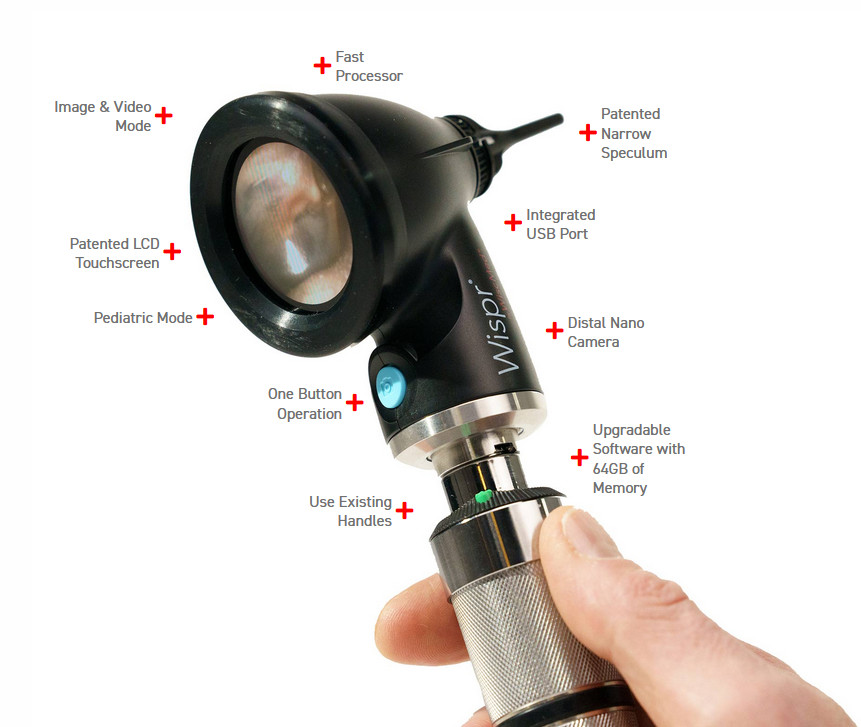APPLICATIONS OF OTOSCOPES WITH INTEGRATED AI

1. Accurate and Rapid Diagnosis in General Medicine
o Primary care professionals can use these otoscopes to evaluate patients quickly and with more confidence, even if they are not ENT specialists.
o Reducing diagnostic errors through automated detection of ear anomalies.
2. Monitoring and Surveillance of Chronic Ear Diseases
o Patients with chronic conditions (such as chronic otitis media) can benefit from more accurate and regular monitoring thanks to the images and data collected by the otoscope.
o Connected otoscopes can generate alerts when they detect significant changes, indicating a possible worsening of the condition.
3. Medical Training and Resident Assistance
o In medical schools and residency programs, AI-enabled otoscopes can help students become familiar with diagnostics by directly showing clinical signs and potential interpretations.
o AI provides real-time feedback, allowing students to train in diagnostics more independently.
4. Telemedicine and Accessibility of Health Care
o AI otoscopes are very useful for telemedicine consultations, where a general practitioner or even a patient, with the help of a healthcare professional, can perform the examination.
o Data and images can be shared immediately with an ENT specialist for further analysis, without the need for travel.
5. Research and Data Collection in Epidemiology
o AI-enabled otoscopes can be used for large-scale data collection on ear conditions, enabling trends to be studied and contributing to public health research.
o Use in school and community screening programs to identify and treat hearing problems in children early.
6. Patient Education and Information
o With AI otoscopes, doctors can directly show patients images of their ear canals and eardrums, helping them better understand their conditions.
o Patients may be more involved in their treatments and more aware of the importance of hearing care.
Examples of AI Otoscope on the Market
1. CELLSCOPE AI OTOSCOPE OTO
DISCONTINUED PRODUCT
o Designed for telemedicine, this digital otoscope provides high-resolution images that can be analyzed by AI and shared with clinicians.
o Used for home examinations and remote consultations, it offers a user-friendly interface for patients and healthcare professionals.
2. WISCMED AI OTOSCOPE
o Designed for use by professionals in clinics, with AI analysis capabilities to aid in the rapid diagnosis of ear infections.
o Has data recording and sharing features, facilitating patient monitoring and remote consultations.
3. TYTOCARE AI OTOSCOPE
o This otoscope is part of a larger telemedicine platform that allows several types of examinations (ears, throat, skin) to be performed with the help of AI.
o Used in home care environments to allow patients to self-perform tests under the supervision of healthcare professionals.
ADVANTAGES AND LIMITATIONS OF AI OTOSCOPES
Benefits :
- Increased diagnostic accuracy and reduced errors through automated detection.
- Improving telemedicine , allowing patients to access quality ear care, even remotely.
- Save time for clinicians as AI provides suggestions and reduces the need for multiple exams.
- Better patient understanding , thanks to real-time visualizations and visual explanations.
Limitations:
- Dependence on AI algorithms : In case of false detection or technical problem, it can affect the diagnosis.
- Privacy and security requirements : Data must be secure, especially when shared or stored in the cloud.
- Initial cost : AI otoscopes can be more expensive than traditional models.
- Training Required : Although user-friendly, users still need to be trained to use these devices effectively.
AI-enabled otoscopes represent a true revolution in the field of otolaryngology and telemedicine, providing healthcare professionals and patients with practical tools for accurate and rapid diagnosis. These devices will likely continue to improve as AI and connectivity technologies improve, making hearing care even more accessible and of higher quality.
